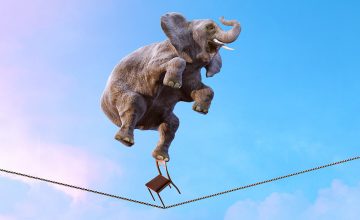
Mainstream Online Web Portal
LoginInvestors can view their accounts online via a secure web portal. After registering, you can access your account balances, periodical statements, tax statements, transaction histories and distribution statements / details.
Advisers will also have access to view their clients’ accounts online via the secure web portal.
The Point
Quick, actionable insights for investors
Income and Fixed Interest

Tim Hext: Inflation looks to be softening. Are sunnier days ahead?
Last week US inflation rose at a slower-than-expected rate, leading to a surge in stocks.
Are sunnier days ahead? Or will this month’s data join earlier false dawns such as July?
“Although not entirely unexpected, lower inflation will continue to provide encouragement to markets that the Fed can slow the pace of hikes (likely 0.5 percentage points in December),” says our head of government bonds Tim Hext.
“Investors should view any decent rallies as an opportunity to de-risk portfolios for the challenges ahead.”
The super-high inflation battle of 2022 may be won. But the outcome of the war is still uncertain, says Tim.
Getting from 9% to 4% next year will be “the easy part”, he says. Commodity shocks from Russia and tight labour markets will likely see inflation get sticky around 4%.
“Unless we tip into a steep recession the US Fed will remain wary about calling victory on inflation soon.”

Tim Hext: The case for inflation-linked bonds
Quick view
Tim Hext: The case for inflation-linked bonds
With the cost of living rising, are inflation-linked bonds a good option?
Returns from inflation-linked bonds are adjusted for inflation, allowing investors to protect real returns. They’re not popular in Australia, which is something of a mystery to our government bonds chief Tim Hext.
“We expect US inflation will fall soon and Australia will follow by mid-2023. Risk markets may take some encouragement from this, but inflation is likely to remain around 3-4%.
In this environment investors need the defensiveness of bonds, which have restored their insurance credentials after this year’s hits, says Tim.
“My recommendation would be to buy inflation-linked bonds. The mainstream investment community seems to prefer standard, nominal bonds — as evidenced by the nominal-only benchmark proposed for bonds in the Your Future Your Super guidelines.
“In my view this is poor policy, overlooking the benefit that inflation-linked bonds provide for retirees or those near retirement.”

TIM HEXT: Mixed signals will remain into Christmas
Quick view
TIM HEXT: Mixed signals will remain into Christmas
After an extraordinary year, investors are hoping for clear air in 2023.
Will we get it?
Next year is when rate hikes fully kick in and the resilience of the real economy will be tested, says Pendal’s head of government bonds Tim Hext.
“Policy-makers are happy for the pain to continue until they see actual – not anticipated – inflation turns,” says Tim.
“Inflation is a lagging indicator – often by six to 12 months. But central banks view an inflation policy mistake as worse than a recession.
“Waiting for supply to solve the problem is proving too much. Demand destruction is required, even though it means people losing jobs and in some cases forced out of homes.”
That means clear air is unlikely until 2024 when a “normal” economy returns, says Tim.

TIM HEXT: Inflation will test Fed’s patience, but RBA has cards up its sleeve
Quick view
TIM HEXT: Inflation will test Fed’s patience, but RBA has cards up its sleeve
US rates are headed for 4% or more after inflation remained high in August.
But the RBA may have more patience, says Pendal’s Tim Hext.
“We still expect goods deflation in the months ahead,” says Tim, who manages our government bond strategies.
“But US wage growth is spreading inflation wider into services. Services inflation is now the battleground.
“As always, Australian bonds will follow the US. But the RBA seems prepared to show a bit more patience due to factors such as wages and our floating-rate mortgage market.
“The RBA remain on course for 3% cash rates by year end (either 2.85% or 3.1%).
“Credit and equity markets were hit by the high inflation numbers, but for now look to be range-trading rather than breaking down.”

TIM HEXT: Interest rate pain probably won’t get too bad despite tough talk
Quick view
TIM HEXT: Interest rate pain probably won’t get too bad despite tough talk
Despite hawkish words from central bankers, cash rates are likely to sit around 3% next year, says our head of government bond strategies Tim Hext.
“One cannot blame them for hawkish comments on inflation, including talk of bringing on the pain,” says Tim.
“After all, their lack of forward-looking policy failed to pick up inflation soon enough in 2021.”
July’s rally — now a distant memory — comes down to the idea that inflation will fall and then stabilise around 4% in the next year.
That’s still too high, meaning rate cuts would be unlikely. But hikes would then stop around neutral and central banks would feel they had time on their side.
If Australia’s central bankers exhibit any patience our cash rates are likely to sit at 3% in 2023, says Tim.
Falling global inflation should allow our central bankers more confidence that we are not in some 1970s style spiral.
“For now, bonds have once again entered the buy zone. I’ll avoid predictions on equities. But I make the observation the landing in the US may not be as hard as many are predicting.”

Tim Hext: Hawkish central banks are telling markets to pay attention
Quick view
Tim Hext: Hawkish central banks are telling markets to pay attention
Markets ignored central bank hawkishness in July, says head of government bond strategies Tim Hext.
“Recession talk was all the rage, which meant rate hikes were largely discounted. Financial conditions — measured by bond rates, credit spreads and equities — eased back to May levels.
“Clearly central banks were not impressed. This week they came out swinging, evangelising restrictive rates needed to rein in inflation.
“In Australia we’re likely to get another 50bp hike in September.
“Rates should finish the year around 3%. High levels of household debt (and heavy stress on 2020 and 2021 buyers) means consumers will be hit hard at that level — let alone at higher rates.
“While the RBA will remains hawkish I doubt they will risk sending households broke by raising rates to 4% — even if markets are now playing with the idea.
“I still prefer inflation bonds for now — but 10-year bonds north of 3.5% are interesting again.

Monthly inflation data is coming. Here’s what it means
What will the new monthly snapshot of inflation data mean for fixed income investors?
“Inflation bonds will continue to index off the quarterly CPI, which is still the ultimate source of truth,” says Pendal’s head of government bond strategies, Tim Hext.
“Inflation bonds remain very cheap despite a likely tailing off in goods inflation in the months ahead.
“Services inflation will remain stubbornly higher in the medium term, whether measured monthly or quarterly.”
While the monthly CPI indicator is welcome news, it does have some shortcomings, says Tim.
Almost half the basket (eg items that are harder to monitor) will continue to be updated quarterly — and not all in the same month.
That will make predicting monthly numbers difficult at first, says Tim.
“At Pendal we’re now building out our models to help predict monthly movements, given markets will respond.”

Consumers and business head in different directions
Quick view
Consumers and business head in different directions
Consumer and business sentiment are heading in different directions according to the latest data.
What’s going on?
Early last year consumer confidence boomed as we escaped from lockdowns with money in our pockets, says Pendal’s Tim Hext.
“Sentiment hit an all-time high in April 2021. Weighed down by rising prices and rate hikes we’ve since plunged almost to the March 2020 low.
“For business, however, it’s hardly looked better. An NAB survey sees business conditions at 20, not far off the April 2021 high of 30 (it averages around 5).”
So far rate hikes have been manageable for consumers, but the next 1% this year will start to bite — heavily for some, says Tim.
Meanwhile tight supply of goods and services means businesses are able to pass on higher costs, maintaining margins and seeing conditions as strong.
“Of course, consumers and business can only be out of step for so long — and 2023 will see a reckoning.”

‘No pre-set path’: What the RBA statement means for investors
Quick view
‘No pre-set path’: What the RBA statement means for investors
Did the RBA this week signal fewer rate hikes ahead? Probably not, says Pendal’s head of government bond strategies Tim Hext.
“We know we’re going to hit neutral this year. Another 1% can be expected, moving the cash rate to 2.85%.
“Whether it’s four lots of 25bp or 50bp at fewer meetings is only of interest to short-end traders. Hence the RBA’s line that it is ‘not on a pre-set path’.
“Sounds like an opportunity for everyone to interpret this with their own confirmation bias — which on Tuesday seemed to be fewer hikes, not more.
“I think that’s reading too much into it.
“As asset owners we must remember the ‘central bank put’ is now also a ‘central bank call’.
“If bonds, equities and credit spreads rally too much without a significant easing in inflation pressures, the RBA will lean against the easing of conditions.
“The rally of the past month suggests this is in danger of happening — so expect more hawkish speeches from officials, especially in the US.”

Fixed interest: why bonds look promising and how to take advantage
Quick view
Fixed interest: why bonds look promising and how to take advantage
A re-assessment of fixed income securities and yields — and their defensive qualities — have recently made bonds attractive again, says Dale Pereira, who heads up client solutions at Pendal.
“Bond returns don’t predict the future — they reflect what’s happened,” says Dale.
“That’s where the opportunity lies: they may be showing negative returns now, but the future looks a lot brighter.”
Bonds typically lead equities in terms of market reaction, says Dale.
“From the end of 2021 and into the first half of 2022, bond yields moved in line with expectations of future rate rises — which in turn reflected inflation expectations.
“But markets often over-react when extrapolating good and bad news. And that’s probably the case now.
“The market has likely priced in too many rate rises. It’s priced in a good chance that central banks won’t be able to control inflation. (Though recently that pricing has started to dissipate, making yields less volatile.)
“This means the bond market is at a much better entry point for investors.”

Amy Xie Patrick: The value proposition for bonds right now
Quick view
Amy Xie Patrick: The value proposition for bonds right now
Investors have been hesitant to include bonds in portfolios in recent years — but that’s changing, says Pendal’s head of income strategies, Amy Xie Patrick.
“The bond story of recent years has been flipped on its head. Buying 10-year government bonds in Australia can get you nearly 4 per cent. At the height of the pandemic, it was 50 basis points.
“Now the credit risk-free rate is 4 per cent, which raises the bar for other asset classes.”
Is 4 per cent a good return, given inflation is currently higher than that?
“Inflation markets infer that over 10 years inflation will average around 2.5 per cent, which is the RBA’s inflation target,” Amy says.
“Ten-year bonds are yielding a nominal rate of 4 per cent. By owning a 10-year Australian bond, you are taking effectively no credit risk, keeping up with the 2.5 per cent long-term rate of inflation and then getting another 1.5 per cent.
“You’re getting paid to own something without credit risk and keep up with inflation.”

Tim Hext: RBA heads back to neutral. But where is neutral?
Quick view
Tim Hext: RBA heads back to neutral. But where is neutral?
The Reserve Bank considers a neutral rate around 2.5% and a bit. But how much is the bit?
“The concept of a neutral cash rate is very fluid,” says Pendal’s head of government bond strategies Tim Hext.
“The best notion is a rate that reflects long-term inflation expectations plus any adjustment for productivity.
“That is, you should expect your cash returns through the long-term cycle to keep pace with inflation and (assuming positive productivity) deliver some small extra return.
“This leads to the notion of 2.5% (the RBA target) plus a bit.”
The size of that “bit” depends on productivity. Strong business lending and new, Covid-driven efficiences are positive signs for productivity.
Against this are the challenges of reduced globalisation and sustainable energy.
Loading posts...
Loading posts...














